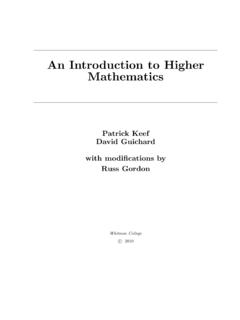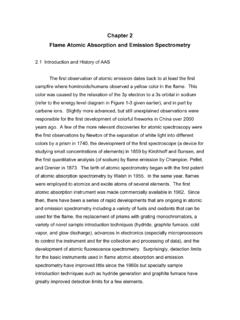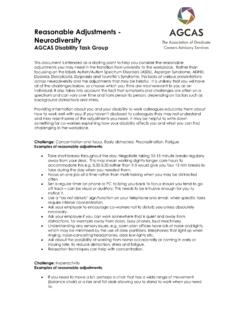Transcription of A short manual for TEXworks - Whitman College
1 A short manual for TEXworksAlain Delmotte, Stefan L ffler, and otherslowering the entry barrier to the TEX worldCopyright 2010 2011 Alain Delmotte, Stefan L ffler, and contrib-utors. Some rights manual is free documentation: you can redistribute it and/ormodify it under the terms of either (i) the CC-BY-SA license aspublished by Creative Commons (either version 3 of the License, or(at your option) any later version) or (ii) the GNU General PublicLicense as published by the Free Software Foundation (either version2 of the License, or (at your option) any later version) or (iii) bothin document is distributed in the hope that it will be useful,but without any warranty; without even the implied warranty ofmerchantability or fitness for a particular of the licenses are available The sources used to create this doc-ument are available Icons and style.
2 32 Under Windows .. Under Linux .. Under Mac OS X .. Ready! ..73 First Interface summary .. Creating a document .. Writing the document .. Typesetting the document and viewing it .. The work of LATEX .. And when errors occur? .. Changing TEXworks parameters for convenience ..154 Going further: Editing Creating a document from a template .. Creating a project using several source files .. Spell-checking .. Search and replace .. Standard functions .. Advanced search and replace (regular expressions) .. Other tools for editing and error tracking .. Standard tools .. Commenting .. Matching delimiters .. Smart quotes .. Auto-completion ..225 Going further: Other SyncTeX ing between source and preview.
3 Special comment strings .. Formatting the source for legibility .. Showing the tags .. Organising the windows .. Cleaning the working folder .. Changing the configuration ..296 Advanced use: Introduction to Scripting .. Installing Scripts .. Using Scripts ..337 Beyond this manual34A Customizing Syntax highlighting .. keyboard shortcuts .. Predefined shortcuts .. Actions listed alphabetically .. Actions listed by menu .. Other actions .. Roots for completion ..44B Regular Introduction .. Codes to represent special sets .. Repetition .. Alternatives and assertions .. Final notes ..63 ContentsiiiC Compiling TEXworks64 Bibliography66 Index671 IntroductionDonald E. Knuth decided to create a new typesetting system, which wouldbe called TEX, because there had been a change in the printing system usedfor the volumes of his bookThe Art of Computer Programmingand Knuthfound the result of the new system goal of TEX was then to have a system which would always producethe same documents independently of the actual machine they were processedon.
4 Knuth also designed theComputer Modernfamily of typefaces and theMETAFONT language for font work initiated in 1977 was finished (the languages were frozen )in 1989. TEX andMETAFONTare not evolving any more except for minorbug fixes (TEX versions are numbered following the decimals of andMETAFONTthe decimals of the number e now ).TEX provides basic tools (commands/instructions/ primitives ) to definetypesetting; almost every detail has to be defined, but the language allows thecreation of macros for repeatedly used constructs. So collections of macrosare loaded through format files ( , pre-compiled large macro collections).Knuth created an original default format (600 commands, more or less)which is calledPlain TEX. This facilitates creating most widely used format is LATEX (Leslie Lamport, 1985), which pro-vides more global commands and structures for documents (article, book.)
5 Allowing easier and faster work, but sometimes with loss of flexibility dueto the more or less rigid framework. But there are many other formats andTEX-variants in use as well, such asAMS-TEX,AMS-LATEX, ConTEXt, orXETEX, each having specific goals and advantages (and drawbacks).To extend the format, one loads packages which are collections of macrosspecific to some aspect of its specification in the late 1970s, the TEX family had to evolve until11. Introduction2now, last version March 2008, to take into account the developments in thetypesetting world outside of the problems to answer were/are: taking into account other languages with alphabets larger than theASCII1one or with non-Latin characters altogether, having more fonts, there is not much variety in the fonts created withMETAFONT(few font creators use it), creating documents in other formats than the normal DVI2, using the rich possibilities of other typesetting systems and formats likePostScript and PDF, having more calculation and scripting facilities.
6 To answer these questions and others, many engines and programmeshave been created around TEX, including pdftex, pdflatex, dvips, ps2pdf, andMETAPOST, which opens the TEX world to the possibilities of PostScriptand be able to use the normal fonts found onthe different machines and to be able to cope with writing systems differentfrom the left to right systems which originated in Europe (Latin and Cyrillicletters and associates) right to left, vertically, pictograms,.. Or LuaTeXand LuaLaTeX to have a powerful scripting use TEX and the systems of its family, one has to create a source document as TEX is only a system to transform a source document into a(beautifully) typeset document. This source is a simple text with typesettinginstructions and one needs a programme to create it: the are many editors able to create a TEX source; some are generaleditors, others are specifically designed for TEX: here TEXworks comes a project to create a text editor for use with the TEXfamily of tools; we will refer to these as (LA)TEX.
7 Instead of creating a newsophisticated program, equipped with multiple tool-bars to meet any need, TEXworks provides a simple editor, offering at first sight only a limited setof tools for text editing as well as a single button and a menu to typeset a(LA)TEX American Standard Code for Information Interchange : a character encoding schemeincluding only Latin characters found in English, some common punctuation characters,and a few other symbols such as % or $2 Device Independent : format of files produced by TEX1. Introduction3 The idea to create the editor came toJonathan Kew, the initiator andleader of the project, after a long period of reflection on the reasons whypotential users tend to keep away from (LA)TEX, as well as pondering thesuccess of theTEXS hopeditor on the the goal was also to provide the same editor on many operatingsystems: TEXworks currently runs on Linux, Mac OS X and Windows.
8 Theinterface is always the same and the program offers the same functionality onall three this introduction, the second section of this manual explains how toinstall the software. In the third section, we describe the interface and createa first document as well as show the basics of TEXworks . In the forth andfifth section, the advanced tools provided by TEXworks are presented; youshould read these sections only after mastering the basic working of advanced tools allow much more effective working practices. The sixthsection gives a brief introduction to scripting. This section focuses on usingready-made scripts, not on writing your own scripts (which is beyond thescope of this manual and will be presented elsewhere). After that, the seventhsection in which some pointers to further information about TEXworks andsources for help are compiled concludes the main , the appendices provide additional information how TEXworks canbe customized, about the regular expression search/replace system, and howTEXworks can be compiled from source.
9 A short bibliography and an indexconclude this Icons and styleBecause a picture is often worth a thousand words, icons and special stylingis used throughout this manual to avoid cumbersome paraphrases or markspecialties. keyboard keys are usually depicted asA, with the exceptionof a few special keys. These are:Shift ,Page ,Page , (return), , , , ,(space),7 (backspace), and (tab).In addition, mouse clicks are depicted as(left click) and(right click;on Mac OS X with a one-button mouse , this is usually available by holdingdownCtrlwhile clicking).Apart from input instructions, several passages throughout this manualare marked by special Introduction4 Information that is only valid or relevant for a particular operating systemis marked like this:This only concerns you if you use course you can also read it if you use another operating just will not be of much use to examples are set in a fixed-space, typewriter font, with lines aboveand below to set it apart from the rest of the text:Hello \TeX-World!
10 Closely related to this, chapter 3 contains several tutorials, which aretypeset just like the code examples above, but with an additional notebookicon next to is only a text editor; to be able to create documents with (LA)TEXand to typeset them to PDF, we also need what is called aTEX is a collection of programs and other files which will be automaticallycalled by TEXworks during its work. Thus, you need to install a distribution:we will do thatbeforestarting TEXworks for the first time, as this way, TEXworks will automatically find what it Live( ), a combination of teTeX,MacTeX and XEmTeX, is available for all three operating systems (Linux,Mac OS X, Windows). The current version is TeX Live 2010. Note that youneed a reasonably recent version of TeX Live (2008 or later at the time ofwriting) to use all features of Linux: most Linux distributions include a TEX distribution, but itmay not be installed by default and you will have to use the Linux packagemanagement tools to do that.









